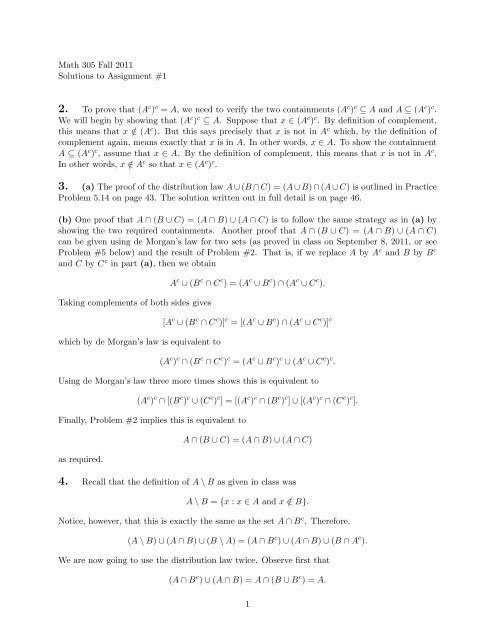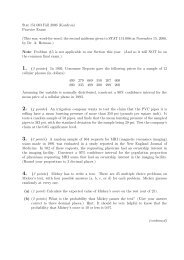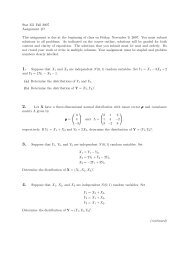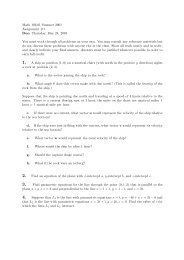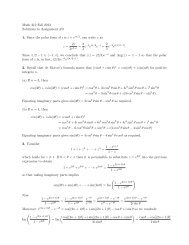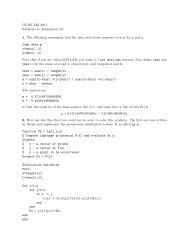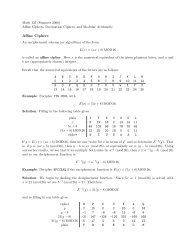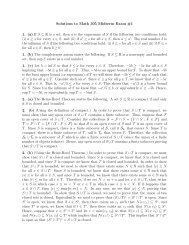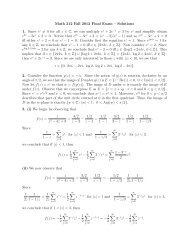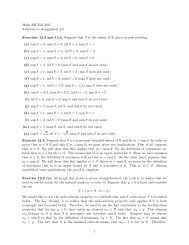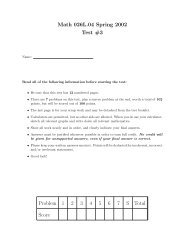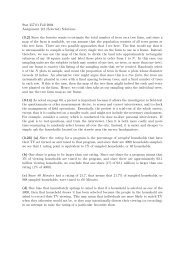Math 305 Fall 2011 Solutions to Assignment #1 2. To prove that (Ac ...
Math 305 Fall 2011 Solutions to Assignment #1 2. To prove that (Ac ...
Math 305 Fall 2011 Solutions to Assignment #1 2. To prove that (Ac ...
You also want an ePaper? Increase the reach of your titles
YUMPU automatically turns print PDFs into web optimized ePapers that Google loves.
<strong>Math</strong> <strong>305</strong> <strong>Fall</strong> <strong>2011</strong><strong>Solutions</strong> <strong>to</strong> <strong>Assignment</strong> <strong>#1</strong><strong>2.</strong> <strong>To</strong> <strong>prove</strong> <strong>that</strong> (A c ) c = A, we need <strong>to</strong> verify the two containments (A c ) c ⊆ A and A ⊆ (A c ) c .We will begin by showing <strong>that</strong> (A c ) c ⊆ A. Suppose <strong>that</strong> x ∈ (A c ) c . By definition of complement,this means <strong>that</strong> x /∈ (A c ). But this says precisely <strong>that</strong> x is not in A c which, by the definition ofcomplement again, means exactly <strong>that</strong> x is in A. In other words, x ∈ A. <strong>To</strong> show the containmentA ⊆ (A c ) c , assume <strong>that</strong> x ∈ A. By the definition of complement, this means <strong>that</strong> x is not in A c .In other words, x /∈ A c so <strong>that</strong> x ∈ (A c ) c .3. (a) The proof of the distribution law A ∪ (B ∩ C) = (A ∪ B) ∩ (A ∪ C) is outlined in PracticeProblem 5.14 on page 43. The solution written out in full detail is on page 46.(b) One proof <strong>that</strong> A ∩ (B ∪ C) = (A ∩ B) ∪ (A ∩ C) is <strong>to</strong> follow the same strategy as in (a) byshowing the two required containments. Another proof <strong>that</strong> A ∩ (B ∪ C) = (A ∩ B) ∪ (A ∩ C)can be given using de Morgan’s law for two sets (as <strong>prove</strong>d in class on September 8, <strong>2011</strong>, or seeProblem #5 below) and the result of Problem #<strong>2.</strong> That is, if we replace A by A c and B by B cand C by C c in part (a), then we obtainTaking complements of both sides giveswhich by de Morgan’s law is equivalent <strong>to</strong>A c ∪ (B c ∩ C c ) = (A c ∪ B c ) ∩ (A c ∪ C c ).[A c ∪ (B c ∩ C c )] c = [(A c ∪ B c ) ∩ (A c ∪ C c )] c(A c ) c ∩ (B c ∩ C c ) c = (A c ∪ B c ) c ∪ (A c ∪ C c ) c .Using de Morgan’s law three more times shows this is equivalent <strong>to</strong>(A c ) c ∩ [(B c ) c ∪ (C c ) c ] = [(A c ) c ∩ (B c ) c ] ∪ [(A c ) c ∩ (C c ) c ].Finally, Problem #2 implies this is equivalent <strong>to</strong>as required.A ∩ (B ∪ C) = (A ∩ B) ∪ (A ∩ C)4. Recall <strong>that</strong> the definition of A \ B as given in class wasA \ B = {x : x ∈ A and x /∈ B}.Notice, however, <strong>that</strong> this is exactly the same as the set A ∩ B c . Therefore,(A \ B) ∪ (A ∩ B) ∪ (B \ A) = (A ∩ B c ) ∪ (A ∩ B) ∪ (B ∩ A c ).We are now going <strong>to</strong> use the distribution law twice. Observe first <strong>that</strong>(A ∩ B c ) ∪ (A ∩ B) = A ∩ (B ∪ B c ) = A.1
Thus, we can substitute this expression in<strong>to</strong> the previous expression <strong>to</strong> conclude <strong>that</strong>(A ∩ B c ) ∪ (A ∩ B) ∪ (B ∩ A c ) = A ∪ (B ∩ A c ).The distribution law now implies <strong>that</strong>A ∪ (B ∩ A c ) = (A ∪ B) ∩ (A ∪ A c ) = A ∪ B.In summary, we have shown <strong>that</strong>(A \ B) ∪ (A ∩ B) ∪ (B \ A) = A ∪ Bas required.5. In order <strong>to</strong> <strong>prove</strong> <strong>that</strong> ⎛⎝ ⋃ j∈J⎞cA j⎠ =j∈J(A ⋂ c j)we will show the two separate containments. <strong>To</strong> begin, suppose <strong>that</strong>⎛ ⎞cx ∈ A j⎠⎝ ⋃ j∈Jso <strong>that</strong> by the definition of complement we conclude <strong>that</strong>x /∈ ⋃ j∈JA j .But this is the same as saying <strong>that</strong> x does not below <strong>to</strong> any one of the sets A j for j ∈ J. That is,x ∈ (A j ) c for every j ∈ J so by the definition of intersection, we concludex ∈ ⋂ j∈J(A c j).On the other hand, ifx ∈ ⋂ j∈J(A c j),then x ∈ A c j for every j ∈ J which by the definition of complement means <strong>that</strong> x /∈ A j for anyj ∈ J. But, by the definition of union, this is exactly the same as saying <strong>that</strong>x /∈ ⋃ j∈JA j .In other words,⎛x ∈ ⎝ ⋃ j∈J⎞cA j⎠and the proof is complete.2
6. I am just going <strong>to</strong> give the answers. You should still <strong>prove</strong> <strong>that</strong> the two sets are equal.(a)⋃ B∈BB = [1, 2] and ⋂ B∈BB = {1}.(b)⋃ B∈BB = (1, 2) and ⋂ B∈BB = ∅. Note <strong>that</strong> (1, 1) = ∅.(c)⋃ B∈BB = [2, ∞) and ⋂ B∈BB = {2}.(d)⋃ B∈BB = [0, 5) and ⋂ B∈BB = [2, 3].3


